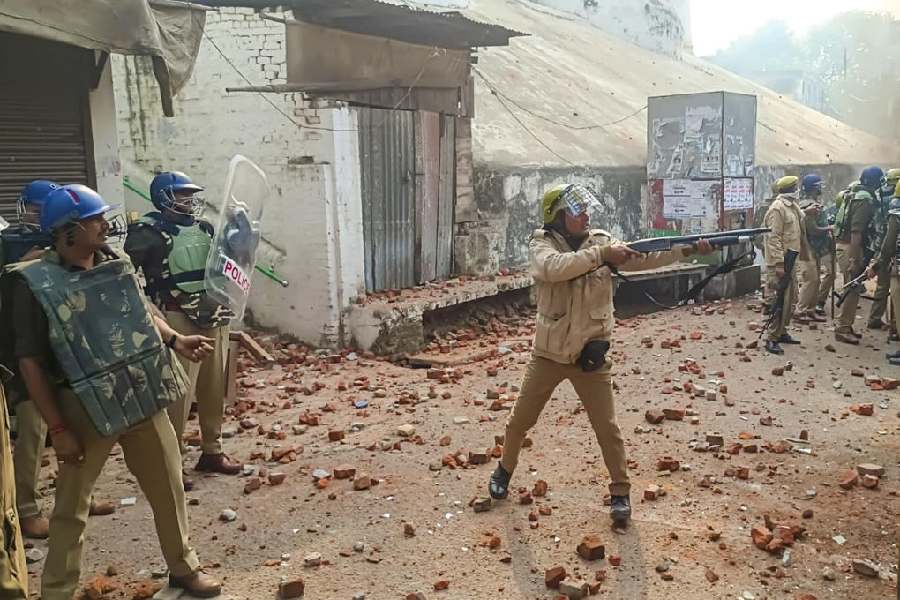 |
| Need of the hour: The law against child trafficking should be honed |
Rani’s story is a familiar one. The 17-year-old resident of a village in Mirzapur, Uttar Pradesh, was sold to a 40-year-old man for Rs 10,000. Sexually abused by policemen whom she approached for help, Rani was later forced to turn to sex work.
Rani’s tale, related in a child helpline website, not only highlights the fact that trafficking is rife in India but that the law on trafficking is still ambiguous.
Activists want legal teeth to combat child trafficking, and believe that one of the ways of dealing with the widespread menace is by punishing clients.
There are some laws, including the Immoral Trafficking (Prevention) Act (ITPA) and the Offences Against Children Act (OACA), that seek to address the issue of using children in sex work. “But these laws, while upholding the interests of children, do not look into certain critical issues such as punishment of clients who solicit children, or the terms of punishment handed out to them,” says Ranjana Kumar, the head of the New Delhi-based Centre for Social Research (CSR).
Clearly, there is an urgent need to hone the law against child trafficking, for the situation is considered grave. The annually compiled Trafficking in Persons 2007 report, released by the United States government, places India on Tier 2 of its watch list. The report, one of the most comprehensive surveys of human trafficking, covers the legal regime and efforts undertaken by countries across the world to combat human trafficking. Countries are ranked by the extent of government action to combat trafficking and their level of compliance with the provisions of the TVPA (Trafficking Victims Protection Act, 2000), a US law that seeks to address the various aspects of domestic and international trafficking.
India has been placed on Tier 2 watch list for the fourth consecutive year for “its failure to show increasing efforts to tackle this large and multidimensional problem”. The report states that India is a source, destination, and transit country for men, women, and children trafficked for the purposes of forced labour and commercial sexual exploitation. But it adds that the Indian government is “making significant efforts to comply with the minimum standards for the elimination of trafficking”.
While no comprehensive study has been undertaken to document the trafficking of children in India, people working in the area hold that child trafficking is extremely widespread in the country. According to Tahniyat (she only uses her first name), programme officer with HAQ: Centre for Child Rights, children are trafficked for commercial sex, domestic work, industrial labour and begging. “An extensive and powerful nexus of traffickers and solicitors drives the domestic and transnational trafficking of children in India.”
At present, no specific legislation on child trafficking exists. Cases are covered by the Immoral Trafficking Act, 1956, the Child Labour Act, 1986, the Juvenile Justice Act, the Bonded Labour Act and so on. Rakesh Sehgal, the national secretary of the Bachpan Bachao Andolan, an organisation working against child labour, draws attention to a major lacuna that exists in the present legal regime for combating child trafficking. “The Immoral Trafficking Act has provisions only for people or children trafficked for sexual exploitation. Children trafficked for other purposes do not fall under the purview of this Act.”
Tahniyat explains that under the present system there is criminalisation of the victims of trafficking. “A trafficked child is viewed and treated as a child in conflict with the law rather than as a child in need of care and protection by the system. Recently, law enforcement agencies rescued 18 child labourers from a zari factory, but as there is no system for rehabilitation of rescued children they were kept for two-three months in government-run shelters where the environment is not conducive for a child to recuperate from the trauma.”
According to Ranjana Kumar of CSR, which is the convener of the South Asia Network Against Trafficking (SANAT), there are many ambiguities in the laws governing the issue of child labour. For one, there is no uniform defining age for children. While the Child Labour Act pegs the age at 14, under other laws it is 16 or 18 years. In Sehgal’s experience, the implementation of the laws leaves a lot to be desired. Often, law enforcement agencies are not familiar with the various provisions and are not trained in handling rescued children.
A long judicial process coupled with the inadequate legal regime to tackle it ensures a low prosecution rate in cases related to child trafficking. In 2006, the government reported only 27 convictions for trafficking across the country.
While widespread poverty results in easy availability of children for trafficking, Tahniyat points to a host of other interconnected circumstances. “Lack of education opportunities, low levels of awareness of parents, gender imbalances in certain regions as a result of female foeticide and sex-specific abortions, the lure of living in a big city and fraudulent marriages create such circumstances. For example, in Haryana, to counter the skewed sex ratio, girls are trafficked from West Bengal.”
Activists rest hope in the proposed Offences Against Children Bill, 2005, hailed as the first bill that comprehensively provides for the protection of children’s rights. The bill seeks to plug the loopholes in the current legal system by making comprehensive provisions for dealing with various types of crimes, including trafficking, involving children. The draft bill if made into an Act will also bring India in conformity with the standards of the United Nations Convention on the Rights of the Child.
However, even a progressive comprehensive law such as the proposed bill is in danger of being reduced to a paper tiger if it is not implemented in letter and spirit. The focus, many believe, should be on protection and safety of child victims during trial by providing fast track courts and making comprehensive provisions for rehabilitating rescued children. Activists maintain that a strong political will and commitment by countries in the subcontinent are required to effectively combat the menace of child trafficking.
Till then, Rani’s story will continue to be an oft-heard one.











